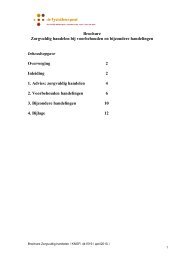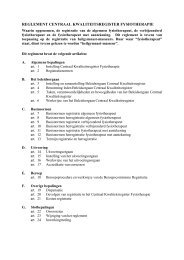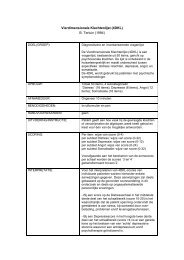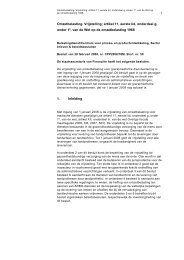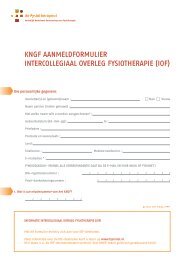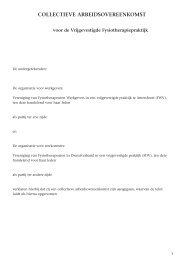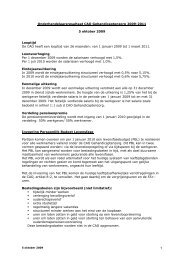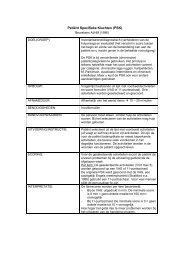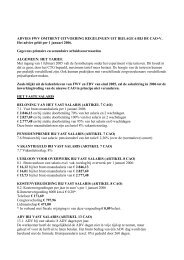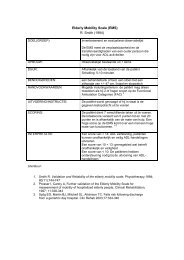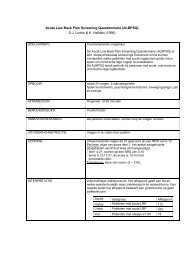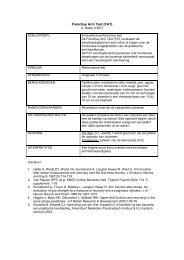Acupuncture and dry-needling for low back pain (Review)
Acupuncture and dry-needling for low back pain (Review)
Acupuncture and dry-needling for low back pain (Review)
You also want an ePaper? Increase the reach of your titles
YUMPU automatically turns print PDFs into web optimized ePapers that Google loves.
Tsukayama 2002<br />
Methods<br />
Participants<br />
Interventions<br />
Outcomes<br />
Notes<br />
-R<strong>and</strong>omized. Computer-generated r<strong>and</strong>om number were used to make a sequence of sealed envelopes. An independent<br />
person prepared an allocation table <strong>and</strong> sealed envelopes.<br />
-Outcome assessors were blinded.<br />
-Funding: Grant from the Foundation <strong>for</strong> Training <strong>and</strong> Licensure Examination in Anma-Massage-Acupressure,<br />
<strong>Acupuncture</strong> <strong>and</strong> Moxibustion” <strong>and</strong> the Tsukuba College of Technology.<br />
-Setting: Private clinic in Tsukuba, Japan.<br />
-The study was approved by the Ethics Committee of TCT Clinic. In<strong>for</strong>med consent was taken from patients<br />
according to the ICH/GCP.<br />
-Fol<strong>low</strong>-up: 19 of 20 patients (95%)<br />
-Analysis: Repeated measures ANOVA. No intention-to-treat analysis<br />
20 patients with <strong>low</strong>-<strong>back</strong> <strong>pain</strong> of at least 2 weeks <strong>and</strong> over 20 years old<br />
Excluded: radiculopathy or neuropathy, fracture, tumour, infection or internal disease, other general heath problem<br />
<strong>and</strong> conflicting or ongoing treatments<br />
Duration of <strong>low</strong> <strong>back</strong> <strong>pain</strong>: acupuncture group=2900 days (+/- 1983) <strong>and</strong> TENS group=3120 days (+/- 3306)<br />
Mean age: 45 years old<br />
Gender: 3 males <strong>and</strong> 16 females.<br />
Working status: not described<br />
Previous treatments: acupuncture (4)<br />
1) <strong>Acupuncture</strong>: Points selected by tenderness <strong>and</strong> palpable muscle b<strong>and</strong>s detected on the <strong>low</strong>er <strong>back</strong> <strong>and</strong> the buttock.<br />
Four points bilaterally (8 in total) were used <strong>for</strong> each treatment. Points most frequently used were BL23 <strong>and</strong> BL26.<br />
Two types of disposable stainless steel needles were used, depending on stature <strong>and</strong> fat: 0.20 mm in diameter <strong>and</strong> 50<br />
mm in length <strong>and</strong> 0.24 mm in diameter <strong>and</strong> 60 mm in length. Needles were inserted into the muscles. The average<br />
insertion depth was approximately 20 mm. Electrostimulation was applied to the inserted needles with an electronic<br />
stimulator with a frequency of 1 Hz <strong>for</strong> 15 minutes. Press tack needles were inserted after EA at four of the 8 chosen<br />
points <strong>and</strong> left in situ <strong>for</strong> several days, they are 1.3 mm long projecting from the sticky side of a small round adhesive<br />
dressing.<br />
Patients were treated twice a week <strong>for</strong> 2 weeks, <strong>for</strong> 4 sessions in total.<br />
R<strong>and</strong>omized to this group: 10. Drop-outs: 1<br />
Experience: unknown<br />
2) TENS: Gel type disposable electrodes of 20x30 mm were used <strong>for</strong> 8 points. Electro-stimulation was applied in the<br />
same manner as in the acupuncture group. The intensity was adjusted to the maximum com<strong>for</strong>table level, <strong>and</strong> muscle<br />
contraction was observed. After each session, a poultice containing methyl salicylic acid, menthol <strong>and</strong> antihistamine<br />
was prescribed to be applied to the <strong>low</strong>-<strong>back</strong> region, at home, in-between treatments.<br />
Patients were treated twice a week <strong>for</strong> two weeks, in total 4 sessions.<br />
R<strong>and</strong>omized to this group: 10. No drop-outs.<br />
1) Pain (VAS): average <strong>pain</strong> level on the previous day.<br />
2) JOA score. See description in Sakai 2001<br />
These outcomes were measured 3 days after the last session.<br />
Costs: not reported<br />
Complications: no adverse events reported by the evaluator. The therapists reported transient aggravation of symptoms<br />
in the acupuncture group (1), discom<strong>for</strong>t due to tack needles (1), <strong>pain</strong> on needle insertion (1) <strong>and</strong> small subcutaneous<br />
bleeding (1). In the TENS group: transient aggravation (1), transient fatigue (1) <strong>and</strong> itching (1)<br />
Language: English<br />
Publication: full paper<br />
For results, see the comparisons:<br />
<strong>Acupuncture</strong> <strong>and</strong> <strong>dry</strong>-<strong>needling</strong> <strong>for</strong> <strong>low</strong> <strong>back</strong> <strong>pain</strong> (<strong>Review</strong>)<br />
Copyright © 2011 The Cochrane Collaboration. Published by John Wiley & Sons, Ltd.<br />
57



